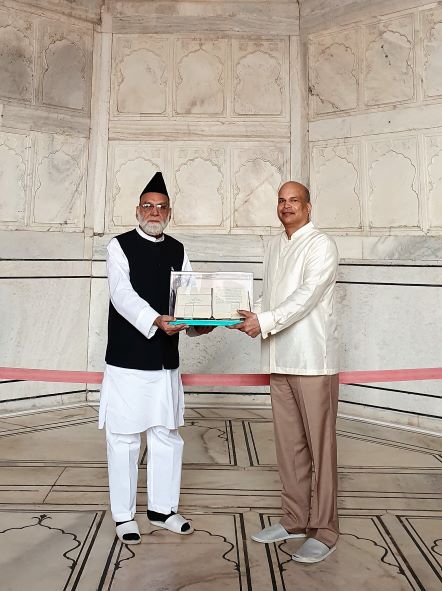Colombo, November 17 (newsin.asia): Further strengthening people-to-people ties with India, the High Commission of Sri Lanka in New Delhi presented a Sinhala translation of the Holy Quran to the Jama Masjid of Delhi for permanent display at the historical mosque built by legendary Mughal Emperor Shah Jahan.
The impressive Sinhala translation of the Holy Quran, published by the All Ceylon Jamiyyathul Ulama (ACJU) of Sri Lanka, was presented to the Chief Imam of India and Shahi Imam of the Jama Masjid of Delhi Syed Ahmed Bukhari this morning by Sri Lanka’s High Commissioner Milinda Moragoda. The copy of the Holy Quran, fixed inside a transparent display box, was placed at a prominent place in the mosque.
Subscribe to our Telegram channel for the latest updates from around the world
READ: Sri Lanka seeks pre-COVID airline schedules from India
Prior to the placement of the Sinhala version of the Holy Quran on permanent display, Sri Lanka’s High Commissioner Milinda Moragoda and Shahi Imam Syed Ahmed Bukhari discussed on a range of issues pertaining to the enhancement of Islamic ties between Sri Lanka and India. The Shahi Imam appreciated this gesture of goodwill and friendship of the people of Sri Lanka and observed that Sri Lanka is a progressive country.

High Commissioner Moragoda requested Imam Bukhari’s assistance in identifying prominent Islamic scholars and dignitaries from India for a possible exchange programme. He also stated that he would encourage Sri Lankan Islamic dignitaries to enhance ties with Imam Bukhari and the Jama Masjid of Delhi.
READ: UK tribunal to decide on Mountbatten Diaries from partition period
The Imam gave a tour of the extremely picturesque mosque adorned with Mughal architectural features, to the High Commissioner of Sri Lanka and his delegation.
The Masjid-i Jehan-Numa, commonly known as the Jama Masjid of Delhi, is one of the largest mosques in India. It was built by the Mughal Emperor Shah Jahan between 1650 and 1656, and inaugurated by its first Imam, Syed Abdul Ghafoor Shah Bukhari. Situated in the former Mughal capital of Shahjahanabad (today Old Delhi), it served as the imperial mosque of the Mughal emperors until the demise of the empire in 1857. The mosque can accommodate 40,000 devotees in prayer.
READ: Does China plan to dodge multilateral events hosted by India?
For similar articles, join our Telegram channel for the latest updates. – click here























































